Thailand Solar Market Size
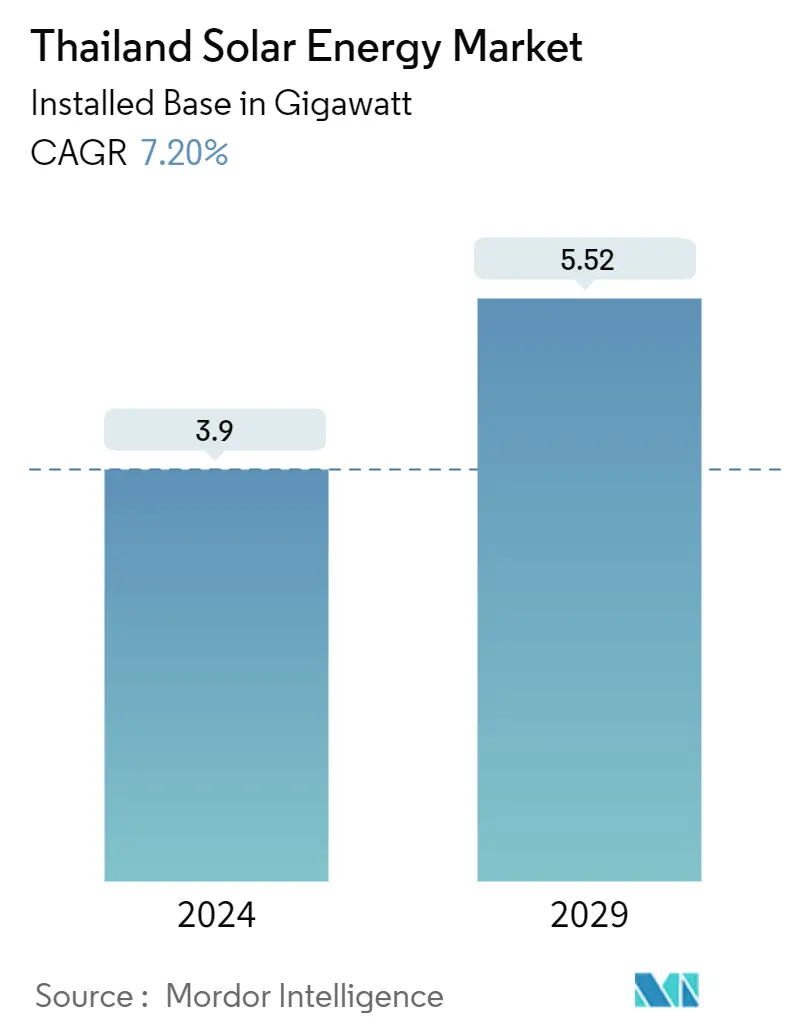
| Study Period | 2020 - 2029 |
| Base Year For Estimation | 2023 |
| Forecast Data Period | 2024 - 2029 |
| Historical Data Period | 2020 - 2022 |
| CAGR (2024 - 2029) | 7.20 % |
| Market Concentration | Medium |
Major Players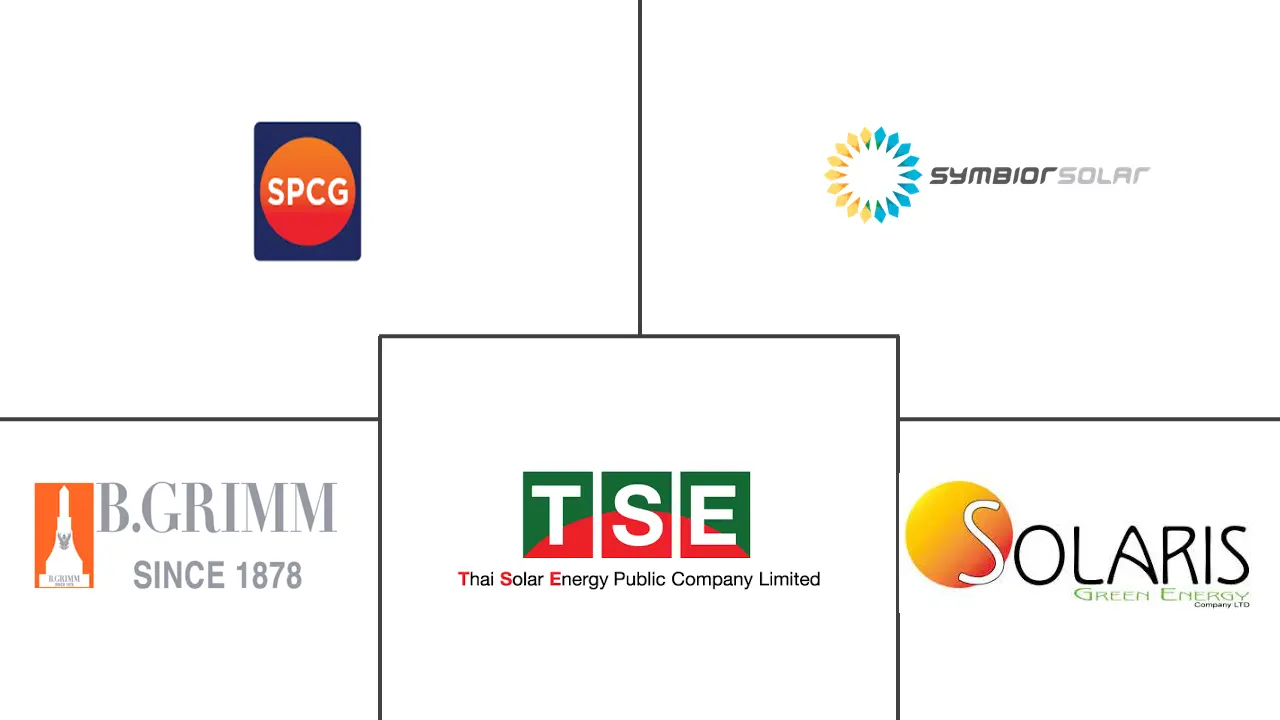
*Disclaimer: Major Players sorted in no particular order |
Thailand Solar Market Analysis
The Thailand Solar Energy Market size in terms of installed base is expected to grow from 3.9 gigawatt in 2024 to 5.52 gigawatt by 2029, at a CAGR of 7.20% during the forecast period (2024-2029).
- Over the long term, factors such as strong government support for solar power development in the form of feed-in tariffs, the Alternative Energy Development Plan (AEDP), and declining costs of solar PV systems are expected to drive the solar energy market in Thailand during the forecast period.
- Conversely, uncertainties regarding access to the power grid are expected to restrain operators from investing in renewable power projects during the forecast period.
- Nevertheless, with a target of reducing GHG emissions in 2030 to 30%, the country is expected to boost opportunities for solar energy companies to install solar PV plants during the coming years. Moreover, the country has plans to reduce dependency upon foreign fossil fuels like crude oil and opt for renewable energy like solar to reduce expenses related to imported oil.
Thailand Solar Market Trends
Solar Photovoltaic (PV) Segment Expected to Dominate the Market
- The solar PV segment is likely to hold the major market share during the forecast period, owing to declining costs of solar modules and the versatility of these systems for various applications, like electricity generation and water heating.
- According to the International Renewable Energy Agency (IRENA), the installed solar PV capacity in Thailand was around 3,060 MW in 2022, up from 1,420 MW in 2015. The growth is the result of large deployments of solar installations, particularly for utility projects. The government has plans to increase the solar PV installed capacity as well.
- The country has several upcoming solar PV projects. the Electricity Generating Authority of Thailand is developing a 778 MW Bhumibol Dam Solar PV Park in Tak. The major project is likely to commence in the year 2024 and is expected to enter into commercial operation after two years.
- Moreover, in February 2023, Charoen Pokphand Foods Public Company Limited (CP Foods) will increase the installation of solar panels at 180 animal farms, feed mills, and processing plants across Thailand, with a total capacity of 65 MW this year. The company is gearing up to reach 100 MW of solar energy in its supply chain in two years.
- Owing to such developments, the solar PV segment is expected to have a dominant market share in Thailand during the forecast period.
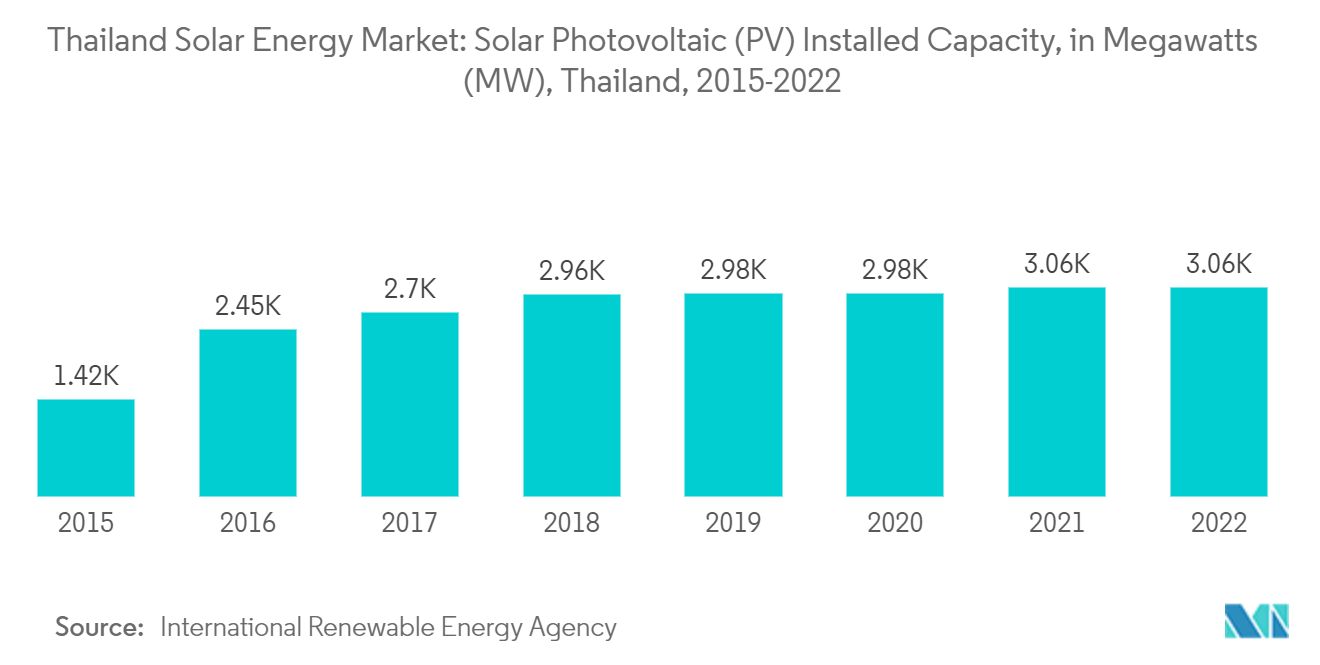
Supportive Government Policies to Drive the Market
- The Thai government is encouraging renewable energy installations across the country to reduce greenhouse gas emissions by 20-25% in seven years. The government has also supported the solar power market by providing various incentives and regulatory support.
- The country has planned to further open its energy market for private electricity trading through the New Solar Rooftop Regulations. As per the regulation, solar PV owners can be connected to the grid for trading electricity, using the power transmission and distribution infrastructure by paying a transmission fee to the public utilities. The fee for retail power trading will be based on the amount of electricity transferred and the congestion level in the transmission line.
- The Thailand's Energy Regulatory Commission is responsible for the promotion of renewable energy in Thailand and its recently issued regulations establish Thailand's feed-in-tariff regime for the sale of electricity by renewable energy projects to state electricity authorities up until this year.
- The country has revised its Power Development Plan (PDP). As per PDP 2020, Thailand plans to add 50 MW of residential rooftop solar and increase up to 250 MW by next year.
- Thailand has set a target for renewables to account for 30% of the power mix by 2037. In 2022, the country installed 12,197 MW of renewable energy capacity, which was higher compared to 7,902 MW in 2015.
- In May 2023, the Electricity Generating Authority of Thailand (EGAT), under the Smart Grid Pilot Project in Mae Hong Son Province, held a Commercial Operation Date (COD) ceremony for the 3 MW Solar Power Plant and 4 MW Battery Energy Storage System (BESS) Project.
- Moreover, the Thai government is supporting the deployment of floating solar energy farms as part of its green energy development plans. Recently, the Industrial Estate Authority of Thailand signed a memorandum of understanding with the Provincial Electricity Authority to build four floating solar plants in four industrial estates with a total capacity of 60 megawatts.
- Therefore, supportive government policies and initiatives are expected to drive the Thai solar energy market in the forecast period.
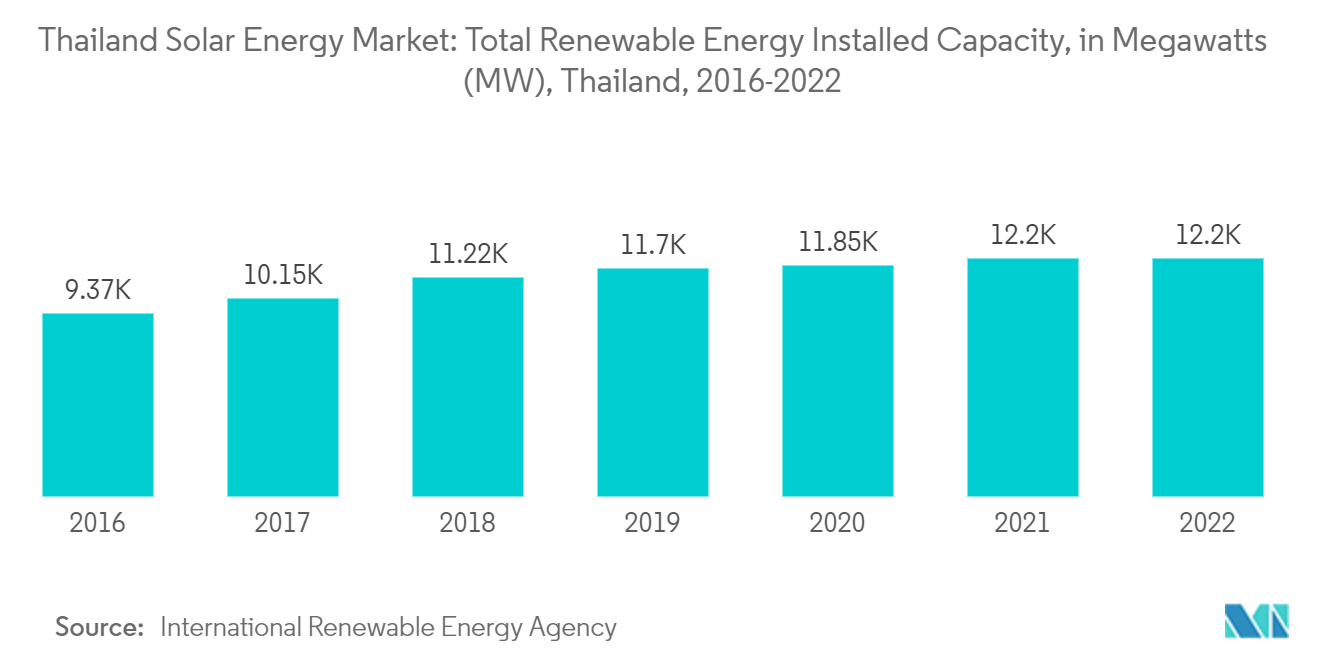
Thailand Solar Industry Overview
The Thailand solar energy market is semi-concentrated. Some of the major companies in the market (in no particular order) include SPCG Public Company Limited, Symbior Energy Limited, Thai Solar Energy PLC, B. Grimm Power Public Company Limited, and Solaris Green Energy Co. Ltd, among others.
Thailand Solar Market Leaders
-
SPCG Public Company Limited
-
Symbior Energy Limited
-
Thai Solar Energy Public Company Limited
-
B.Grimm Power Public Company Limited
-
Solaris Green Energy Co., Ltd
*Disclaimer: Major Players sorted in no particular order
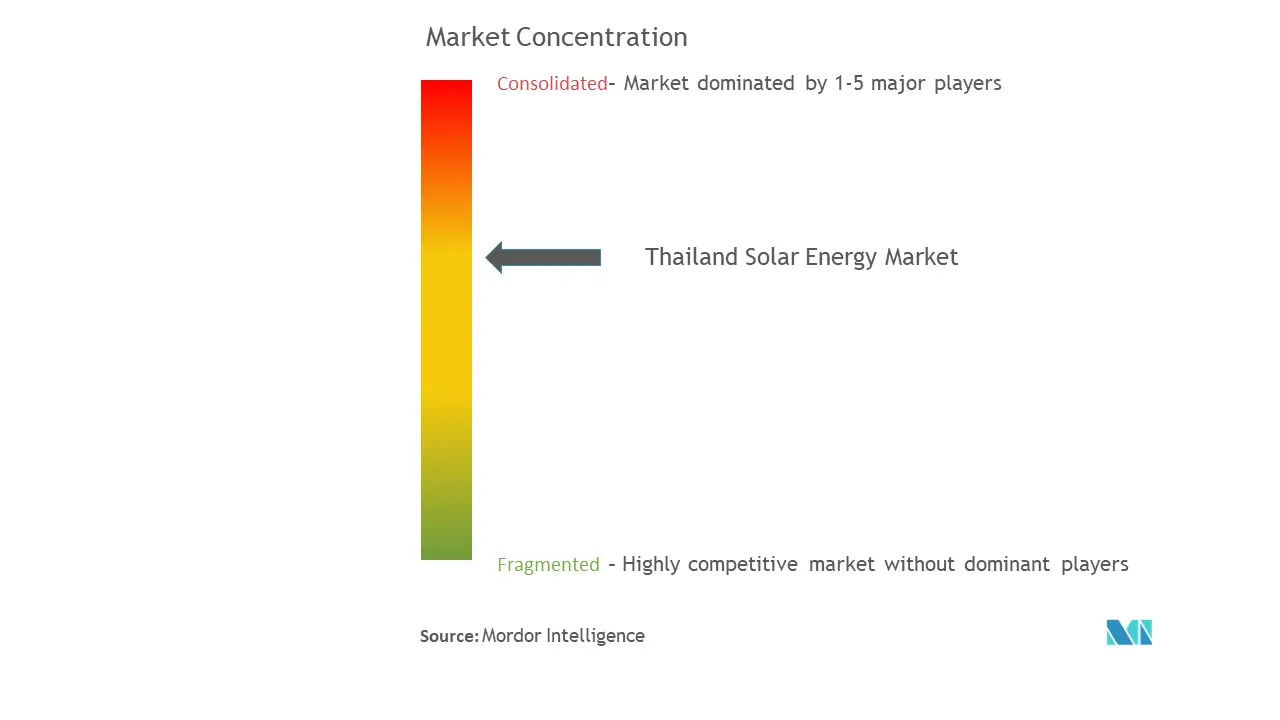
Thailand Solar Market News
- June 2023: National Power Supply Public Company Limited (NPS) has completed the installation of the first phase of the 60 MW floating solar power plant on the well. The plant will start generating electricity in the fourth quarter of 2023. Also, the company is installing a 90 MW Floating Solar Farm Phase 2 which is expected to be completed and ready to generate electricity in the first quarter of next year.
- March 2023: Falken Tires, a global tire company, announced the construction of extensive solar panel installation on a single facility, covering an area of 100,000 square metres, equivalent to over 18 football pitches. This installation is being constructed at the Sumitomo Rubber Industries (SRI) factory in Thailand, where Falken is a subsidiary. The installation comprises 40,000 solar panels with a combined output of 22MW and is set to be completed in two years.
Thailand Solar Market Report - Table of Contents
1. INTRODUCTION
- 1.1 Scope of the Study
- 1.2 Market Definition
- 1.3 Study Assumptions
2. EXECUTIVE SUMMARY
3. RESEARCH METHODOLOGY
4. MARKET OVERVIEW
- 4.1 Introduction
- 4.2 Solar Energy Installed Capacity and Forecast, until 2028
- 4.3 Recent Trends and Developments
- 4.4 Government Policies and Regulations
-
4.5 Market Dynamics
- 4.5.1 Drivers
- 4.5.1.1 Favorable Government Policies and Increasing Adoption of Solar PV Systems
- 4.5.1.2 Soaring Electricity Prices Incentivized Installing Solar PV Systems for Self-Consumption
- 4.5.2 Restraints
- 4.5.2.1 The Growth of Other Renewable Technologies Such as Wind and Bioenergy
- 4.6 Supply Chain Analysis
- 4.7 PESTLE Analysis
5. MARKET SEGMENTATION
-
5.1 Technology
- 5.1.1 Solar Photovoltaic (PV)
- 5.1.2 Concentrated Solar Power (CSP)
6. COMPETITIVE LANDSCAPE
- 6.1 Mergers and Acquisitions, Joint Ventures, Collaborations, and Agreements
- 6.2 Strategies Adopted by Leading Players
-
6.3 Company Profiles
- 6.3.1 SPCG Public Company Limited
- 6.3.2 Symbior Energy Limited
- 6.3.3 Thai Solar Energy PLC
- 6.3.4 B. Grimm Power Public Company Limited
- 6.3.5 Solaris Green Energy Co. Ltd
- 6.3.6 Energy Absolute PCL
- 6.3.7 Solartron PLC
- 6.3.8 Marubeni Corporation
- 6.3.9 Black & Veatch Holding Company
- *List Not Exhaustive
7. MARKET OPPORTUNITIES AND FUTURE TRENDS
- 7.1 The country's target of reducing GHG emissions in 2030 to Create Opportunities for Solar Energy Market
Thailand Solar Industry Segmentation
Solar power is the conversion of solar energy into thermal or electrical energy. Solar energy is the cleanest and most abundant renewable energy source accessible, and it may be used to generate electricity, provide light or a comfortable interior environment, and heat water for home, commercial, or industrial purposes.
The Thailand solar energy market is segmented by technology. By technology, the market is segmented into solar photovoltaic (PV) and concentrated solar power (CSP). For each segment, the market size and forecasts have been done based on installed capacity.
| Technology | Solar Photovoltaic (PV) |
| Concentrated Solar Power (CSP) |
Thailand Solar Market Research FAQs
How big is the Thailand Solar Energy Market?
The Thailand Solar Energy Market size is expected to reach 3.9 gigawatt in 2024 and grow at a CAGR of 7.20% to reach 5.52 gigawatt by 2029.
What is the current Thailand Solar Energy Market size?
In 2024, the Thailand Solar Energy Market size is expected to reach 3.9 gigawatt.
Who are the key players in Thailand Solar Energy Market?
SPCG Public Company Limited, Symbior Energy Limited, Thai Solar Energy Public Company Limited, B.Grimm Power Public Company Limited and Solaris Green Energy Co., Ltd are the major companies operating in the Thailand Solar Energy Market.
Which segment is expected to hold a major Thailand Solar Energy Market share?
The solar photovoltaic (PV) segment is expected to hold a major Thailand Solar Energy Market share.
Thailand Solar Industry Report
The Thailand solar energy market is experiencing significant growth, driven by supportive government policies and the decreasing costs of solar photovoltaic (PV) systems. Segmented by technologies, including concentrated solar power (CSP) and solar photovoltaic (PV), and by deployments such as rooftop and ground-mounted installations, the market is adapting to meet increasing demands. The solar PV segment is expected to dominate due to its high efficiency, durability, and rising corporate interest in achieving renewable energy targets. CSP technology is also anticipated to expand rapidly due to its commercial viability and extensive use in various end-user industries. The commitment of the Thai government to renewable energy targets, supported by feed-in tariffs and other incentives, is propelling the market forward, making solar energy in Thailand a key player in the region's energy sector. Challenges such as grid access uncertainties and land availability for large solar plants persist, but ongoing research and development are expected to continue reducing costs and enhancing technology. Renewable energy companies in Thailand are pivotal in driving this growth, focusing on reducing dependency on fossil fuels and increasing the installation of renewable energy sources like solar to meet growing energy demands and environmental goals. Get insights from Mordor Intelligence™ Industry Reports, which include a market forecast outlook and historical overview, available as a free report PDF download.



